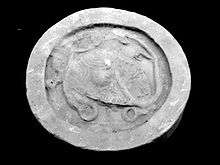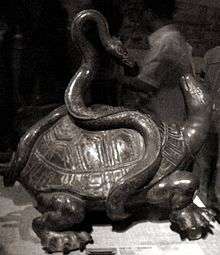Black Tortoise
|
Black Tortoise Black Turtle | |||||||||||||||||
 The Black Tortoise depicted on a Chinese tile | |||||||||||||||||
| Chinese name | |||||||||||||||||
|---|---|---|---|---|---|---|---|---|---|---|---|---|---|---|---|---|---|
| Chinese | 玄武 | ||||||||||||||||
| Literal meaning |
Dark Warrior Mysterious Warrior | ||||||||||||||||
| |||||||||||||||||
| Vietnamese name | |||||||||||||||||
| Vietnamese alphabet | Huyền Vũ | ||||||||||||||||
| Korean name | |||||||||||||||||
| Hangul | 현무 | ||||||||||||||||
| Hanja | 玄武 | ||||||||||||||||
| |||||||||||||||||
| Japanese name | |||||||||||||||||
| Kanji | 玄武 | ||||||||||||||||
| Hiragana | げんぶ | ||||||||||||||||
| |||||||||||||||||
| Black Warrior of the North | |||||||
 | |||||||
| Chinese | 北方玄武 | ||||||
|---|---|---|---|---|---|---|---|
| |||||||
The Black Tortoise or Black Turtle is one of the Four Symbols of the Chinese constellations. Despite its English name, it is usually depicted as a turtle entwined together with a snake. Further, in East Asia, it is not called after either animal but is instead known as the "Black Warrior" under various local pronunciations. It is known as Xuanwu in Chinese, Hyeonmu in Korean, Genbu in Japanese and Huyền Vũ in Vietnamese. It represents the north and the winter season.
In Japan, it is one of the four guardian spirits that protect Kyoto and it is said that it protects the city on the north. Represented by the Genbu Shrine,[1] which is located to the north of Kyoto Imperial Palace.
The creature's name is identical to that of the important Taoist god Xuanwu, who is sometimes (as in Journey to the West) portrayed in the company of a turtle and snake.
History
In ancient China, the tortoise and the serpent were thought to be spiritual creatures symbolizing longevity. The Fujianese custom of building turtle-shaped tombs may have had to do with the desire to place the grave under the influence of the Black Tortoise.[2][3] During the Han dynasty, people often wore jade pendants that were in the shape of turtles. Because of ancient Chinese influence on Japan, honorific titles and badges in Japan also often referred to the turtle or tortoise.
The northern gates of Chinese palaces were often named after the Xuanwu. Most famously, the Incident at Xuanwu Gate, where Li Shimin killed his brothers Jiancheng and Yuanji and seized power in a coup, took place at the north gate of the Taiji Palace, in the north of Chang'an.
Legends
Xuanwu
In the classic novel Journey to the West, Xuanwu was a king of the north who had two generals serving under him, a "Tortoise General" and a "Snake General". This god had a temple in the Wudang Mountains of Hubei and there are now a "Tortoise Mountain" and a "Snake Mountain" on opposite sides of a river near Wuhan, Hubei's capital. Taoist legend has it that Xuanwu was the prince of a Chinese ruler but was not interested in taking the throne, opting instead to leave his parents at age 16 and study Taoism. According to the legend, he eventually achieved divine status and was worshiped as a deity of the northern sky.
Other Chinese legends also speak of how the "Tortoise General" and a "Snake General" came to be. During Xuanwu's study to achieve enlightenment and divine status, he was told that, in order to fully achieve divinity, he must purge all human flesh from his body. Since he had always eaten the food of the world, despite all his efforts, his stomach and intestines were still human. A god then came and changed his organs with divine ones. Once removed, the original stomach and intestines were said to have become a tortoise and a snake, respectively. The tortoise and snake became demons and terrorized people. Now divine, Xuanwu heard of this and returned to slay the monsters he had unleashed on the countryside. However, as the snake and tortoise showed remorse, he did not kill them but instead let them train under him to atone for their wrongdoings. They then became the Tortoise and Snake generals and assisted Xuanwu with his quests. (Another legend held that the mortal organs were tossed out to become Wuhan's Tortoise and Snake mountains.)
According to another source, once Xuanwu had begun his study of the Way, he discovered that he must purge himself of all of his past sins to become a god. He learned to achieve this by washing his stomach and intestines in the river. Washing his internal organs, his sins dissolved into the water in a dark, black form. These then formed into a black tortoise and a snake who terrorized the country. Once Xuanwu learned of this, he returned to subdue them as in the other story.
Astronomy
As with the other three Symbols, there are seven "mansions" (positions of the moon) within Black Tortoise. The names and determinative stars are:[4][5]
| Mansion no. | Name | Pinyin | Translation | Determinative star |
|---|---|---|---|---|
| 8 | 斗 | Dǒu | (Southern) Dipper | φ Sgr |
| 9 | 牛 | Niú | Ox | β Cap |
| 10 | 女 | Nǚ | Girl | ε Aqr |
| 11 | 牛 | Xū | Emptiness | β Aqr |
| 12 | 危 | Wēi | Rooftop | α Aqr |
| 13 | 室 | Shì | Encampment | α Peg |
| 14 | 壁 | Bì | Wall | γ Peg |
See also
- Ao, the great turtle of early Chinese mythology
- Bixi, the son of the Dragon King who supports Chinese stelæ
- Four Benevolent Animals of China
- Four Holy Beasts of Vietnam
- Fushigi Yuugi Genbu Kaiden
- Fushigi Yûgi
References
- ↑ "Archived copy". Archived from the original on 2016-11-06. Retrieved 2014-09-29.
- ↑ de Groot, Jan Jakob Maria (1892), The Religious System of China, III, Brill Archive, pp. 1082–1083
- ↑ 李永球 (Li Yongqiu) (2010-03-07), "各籍貫墳墓造型 (In every land, its own kind of graves)", Sin Chew Daily
- ↑ "The Chinese Sky". International Dunhuang Project. Retrieved 2011-06-25.
- ↑ Sun, Xiaochun (1997). Helaine Selin, ed. Encyclopaedia of the History of Science, Technology, and Medicine in Non-Western Cultures. Kluwer Academic Publishers. p. 517. ISBN 0-7923-4066-3. Retrieved 2011-06-25.
External links
| Wikimedia Commons has media related to Black Tortoise. |